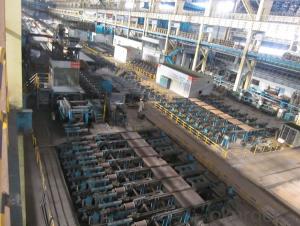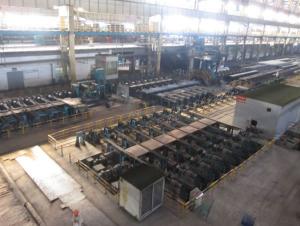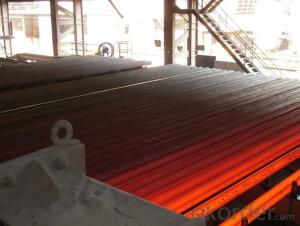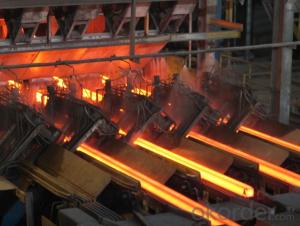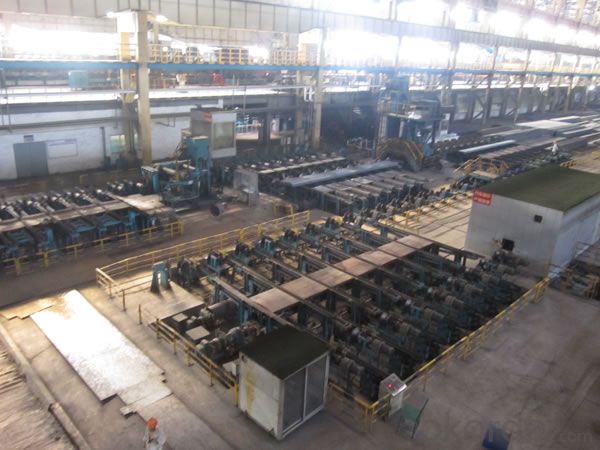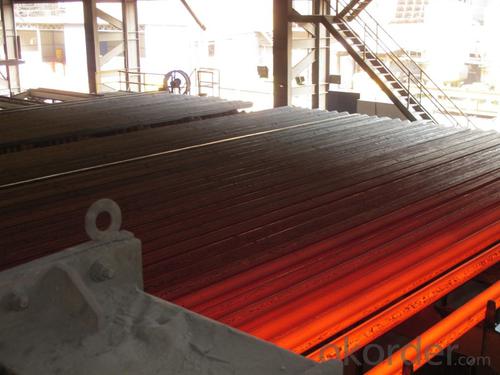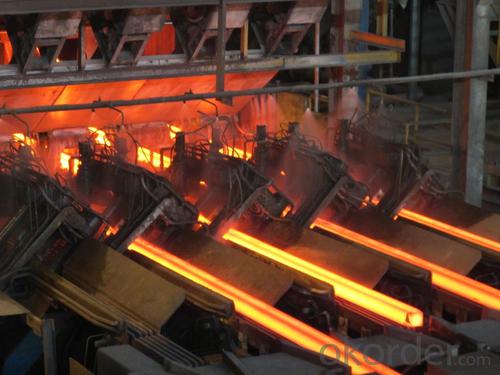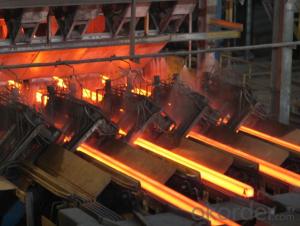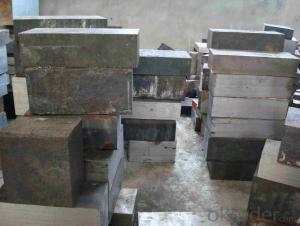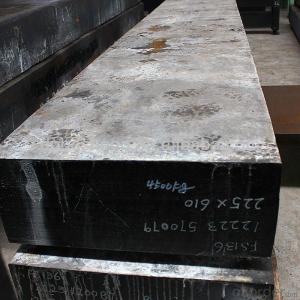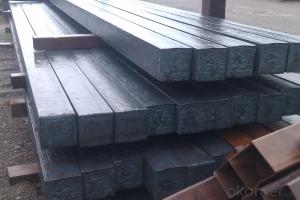Prime quality square alloy steel billet 105mm Q235
- Loading Port:
- Tianjin
- Payment Terms:
- TT OR LC
- Min Order Qty:
- 100 m.t.
- Supply Capability:
- 10000 m.t./month
OKorder Service Pledge
OKorder Financial Service
You Might Also Like
Structure of Prime quality square alloy steel billet 105mm Q235
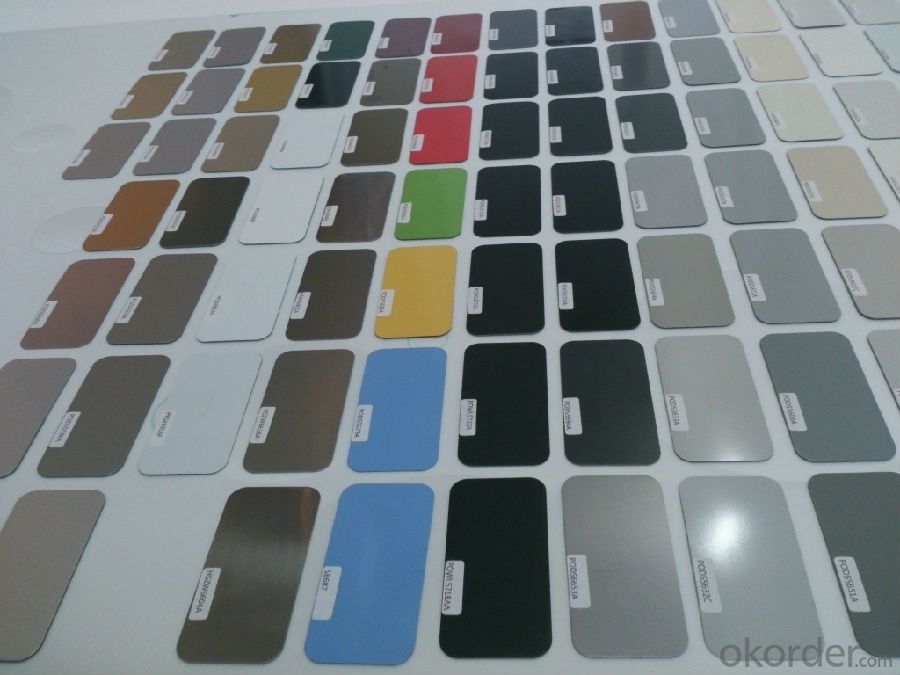
Description of Prime quality square alloy steel billet 105mm Q235
1. Prepainted steel coil is coated with organic layer, which provides higher anti-corrosion property and a longer lifespan than that of galvanized or galvalume steel sheets.
2. The base metals for prepainted steel coil consist of cold rolled, HDGI Steel, electro-galvanized and hot-dip alu-zinc coated steel. The finish coats of prepainted steel coil can be classified into groups as follows: polyester, silicon modified polyesters, polyvinylidene fluoride, high-durability polyester, etc.
3. The production process has evolved from one-coating-and-one-baking to double-coating-and-double-baking, and even three-coating-and-three-baking.
4. The color of the prepainted steel coil has a very wide selection, like orange, cream-colored, dark sky blue, sea blue, bright red, brick red, ivory white, porcelain blue, etc.
5. The prepainted steel coils can also be classified into groups by their surface textures, namely regular prepainted sheets, embossed sheets and printed sheets.

Main Feature of Prime quality square alloy steel billet 105mm Q235
Uncoated CR steel sheet
With the features of in line with the international highest standards in demension and shape, excellent surface finish and properties, the products are mainly used in home appliance and automobile industries.
Galvanized steel sheet(include HDG and EG)
With the features of good corrosion resistance, the products are mainly used in automobile, home appliance, electronics, building and machinery manufacture industries, etc.
Precoated steel sheet
With the features of enviromental protection and good processablility, long lasting surface durability, rich in colors, the products are maily used in building, home appliance and furniture industries, etc.
Applications of Prime quality square alloy steel billet 105mm Q235
Construction
Manufacture anticorrosion, industrial and civil architecture roof boarding, roof grille
Light industries
Home appliance's case, civil chimney, kitchen utensils
Auto industry
Corrosion resistant parts of cars
Agriculture
Food storage, meat and aquatic products' freezing and processing equipment
Commerce
Equipments to store and transport materials, and packing implements

Specifications of Prime quality square alloy steel billet 105mm Q235
Product | Prime quality square alloy steel billet 105mm Q235 |
Material Grade | SGCC / SGCH / DX51D+AZ, etc |
Thickness | 0.6-3.0mm |
Width | 500-1500mm |
Tolerance | Thickness: +/-0.02mm , Width:+/-2mm |
Zinc-coating | Z30-150g/m2 |
Technique | Raw material: Hot rolled steel coil --> Cold rolled_>hot dipped galvalume |
Surface | Dried, Chromated, Unoiled |
Spangle | Regular spangle , small spangle, zero spangle |
ID | 508MM 610MM |
Coil weight | 1-25MT |
Export package | Cardboard inner sleeves, Waterproof paper, galvanized steel covered and steel strip packed |
FAQ of Prime quality square alloy steel billet 105mm Q235
We have organized several common questions for our clients,may help you sincerely:
1. How Can I Visit There?
Our company is located in Tianjin City, China, near Beijing. You can fly to Tianjin Airport Directly. All our clients, from home or aboard, are warmly welcome to visit us!
2. How Can I Get Some Sample?
We are honored to offer you sample.
3. Why choose CNBM?
Our delivery time about 15-20days for standard sizes, if you have other requirements like hardness, quanity and width ,it is about 20-40days. But don't worry we also try our best for the delivery time ,because time longer and our cost is higher.
- Q: Difference between medium frequency continuous casting billet and electric furnace continuous casting billet
- 5, if the intermediate frequency furnace supporting a reasonable refining facilities, also can produce high quality steel, even more than the electric arc furnace steelmaking, specific processes can be used: +VOD+LF process of intermediate frequency furnace can produce very good steel.
- Q: What are steel billets?
- Steel billets are semi-finished metal products that are rectangular in shape and usually have a square cross-section. They are produced through a process called casting or continuous casting, where liquid steel is poured into molds and allowed to cool and solidify. Once cooled, the billets are typically hot-rolled or forged to give them their final shape and dimensions. Steel billets serve as a raw material for the production of various steel products, such as bars, rods, wires, and structural sections. They are commonly used in the construction industry for structural purposes, as well as in the manufacturing of automotive parts, pipes, and machinery. The quality of steel billets is crucial, as it directly affects the quality and performance of the final steel products. Therefore, they undergo rigorous quality checks and testing to ensure they meet the required standards for strength, durability, and other mechanical properties. Overall, steel billets play a vital role in the steel industry as a primary raw material for the production of a wide range of steel products, making them an essential component in various sectors of the economy.
- Q: What is the process of heat treatment for steel billets?
- The process of heat treatment for steel billets involves subjecting the billets to controlled heating and cooling cycles to alter their mechanical properties. This process is essential in increasing the hardness, strength, and toughness of the steel billets, making them suitable for various industrial applications. The heat treatment process begins with the heating stage, where the steel billets are heated to a specific temperature range. This temperature is typically above the critical point of the steel, which allows for the transformation of its microstructure. The heating can be done using various methods, including electric furnaces, gas furnaces, or induction heating. Once the desired temperature is reached, the billets are held at that temperature for a specified amount of time to ensure the uniformity of the heat distribution throughout the billet. This stage is known as soaking or holding, and it allows for the homogenization of the microstructure. After the soaking stage, the billets are subjected to cooling, which is equally important as the heating stage. The cooling rate is carefully controlled to achieve the desired properties. The cooling can be done through various methods, such as air cooling, oil quenching, or water quenching. Each method provides different cooling rates and results in different material properties. During the cooling stage, the steel undergoes a phase transformation, which results in the formation of different microstructures. For example, rapid cooling through water quenching can lead to the formation of martensite, a hard and brittle microstructure, while slower cooling can result in the formation of pearlite, a softer and ductile microstructure. Once the cooling is complete, the steel billets are often subjected to additional processes such as tempering or annealing. Tempering involves reheating the steel to a specific temperature and holding it there for a certain period, followed by controlled cooling. This process reduces the brittleness of the steel and improves its toughness and ductility. Annealing is another heat treatment process that involves heating the steel to a specific temperature and then slowly cooling it. This process is used to relieve internal stresses, refine the grain structure, and enhance the machinability of the steel. Overall, the process of heat treatment for steel billets involves carefully controlled heating, soaking, cooling, and sometimes additional processes to achieve the desired mechanical properties. This process is crucial in enhancing the performance and durability of steel billets, making them suitable for various industrial applications such as construction, automotive, and machinery.
- Q: How are the surface defects of steel billets repaired?
- The surface defects of steel billets can be repaired through various methods, depending on the type and severity of the defect. Some common surface defects include cracks, seams, laps, and scale. One method of repairing surface defects is through grinding or milling. This involves removing the surface layer of the billet using abrasive tools or machines. Grinding can effectively eliminate small defects such as scale, pits, or minor cracks. However, it may not be suitable for deep or extensive defects. For more severe defects like cracks or seams, a common repair technique is welding. The damaged areas are preheated to a suitable temperature, and then the cracks or seams are filled using welding electrodes or filler materials. This process requires skilled welders to ensure proper fusion and strength of the repaired area. In some cases, surface defects can be repaired through mechanical methods such as peening or hammering. These techniques involve using specialized tools to reshape and smooth out the affected areas. Peening can be effective for eliminating shallow cracks or surface irregularities. Ultrasonic testing is another method used to identify and repair surface defects in steel billets. It involves using high-frequency sound waves to detect any hidden cracks or flaws. Once the defects are identified, appropriate repair methods can be employed. It is important to note that the repair process for surface defects in steel billets requires careful inspection and assessment to determine the most suitable method. Quality control measures must be put in place to ensure that the repaired billets meet the required standards for strength and integrity.
- Q: How are steel billets used in the manufacturing of pipes?
- Steel billets are the initial raw material used in the manufacturing of pipes. They are heated and then passed through a series of rollers to form a cylindrical shape. These billets are then elongated and shaped into seamless pipes or welded together to create welded pipes. The high strength and durability of steel billets make them ideal for pipe production, ensuring the pipes can withstand high-pressure environments and various applications such as oil and gas transportation, plumbing, construction, and more.
- Q: How are steel billets used in the production of power transmission equipment?
- Power transmission equipment relies heavily on steel billets, which are indispensable for their production. Gears, shafts, and couplings, vital components of power transmission equipment, necessitate materials that possess both high strength and durability to endure the forces and stresses involved in transmitting power. Steel billets, categorized as semi-finished steel products, play a pivotal role in meeting these requirements. Primarily, steel billets serve as the raw material for forging or casting processes, enabling the creation of diverse power transmission equipment components. Through forging, billets are subjected to high temperatures and shaped under immense pressure, resulting in a robust and compact material with exceptional mechanical properties. On the other hand, casting involves pouring molten steel into molds to form intricate shapes. In this process, steel billets are melted and cast into molds to fabricate complex components like gears or shafts. Moreover, the composition and quality of steel billets are meticulously controlled to ensure the final product aligns with the specific demands of power transmission equipment. Steel billets are manufactured using various steel grades, each possessing distinct properties such as strength, hardness, and wear resistance. The selection of the appropriate steel grade relies on the particular application and operating conditions of the power transmission equipment. For example, a gear employed in heavy-duty industrial machinery may require a higher strength steel billet compared to a gear used in a smaller-scale application. Additionally, steel billets can undergo further processing, such as heat treatment, to enhance their mechanical properties. Heat treatment processes like quenching and tempering have the potential to bolster the hardness, toughness, and overall performance of the billets. This guarantees that the final power transmission equipment possesses the necessary strength and durability to withstand the challenges associated with power transmission. In conclusion, steel billets play a paramount role in the production of power transmission equipment due to their strength, durability, and flexibility. They act as the raw material for forging or casting processes, facilitating the creation of intricate components. Meticulous selection of steel grade and utilization of heat treatment processes ensure that the final product meets the specific requirements of power transmission equipment, solidifying the integral role of steel billets in the manufacturing process.
- Q: What are the different surface treatments for improved machinability in steel billets?
- To enhance the machinability of steel billets, there are multiple surface treatments available. These treatments aim to optimize cutting performance and minimize tool wear during machining operations. Here are some common methods used to improve machinability in steel billets: 1. Nitriding: Nitriding is a surface hardening treatment that utilizes nitrogen to form a durable and wear-resistant layer on the steel billet's surface. By undergoing this treatment, the cutting performance is enhanced, and tool wear during machining is reduced. 2. Carburizing: Carburizing is a process that involves infusing carbon into the surface of the steel billet to increase its hardness and wear resistance. This treatment improves machinability by creating a harder surface layer capable of withstanding higher cutting speeds and loads. 3. Coating: The application of various coatings on the surface of steel billets can decrease friction and enhance machinability. Examples of such coatings include titanium nitride (TiN) and diamond-like carbon (DLC) coatings. These coatings minimize tool wear and improve cutting performance. 4. Shot peening: Shot peening is a surface treatment that entails bombarding the steel billet's surface with small spherical particles. This treatment induces compressive stress, enhancing fatigue resistance and decreasing the likelihood of crack initiation during machining. 5. Cold working: Cold working involves deforming the steel billet at room temperature to increase its hardness and improve machinability. Cold rolling or cold drawing are processes commonly employed to achieve this treatment. It is crucial to bear in mind that the selection of a surface treatment for improved machinability in steel billets depends on various factors, including the specific steel alloy, desired surface properties, and intended machining process. Consequently, it is essential to consider these factors and seek expert advice to determine the most suitable surface treatment for a particular application.
- Q: How are steel billets used in the manufacturing of industrial machinery parts?
- Steel billets possess unique properties and versatility, making them indispensable for the production of industrial machinery parts. These semi-finished steel products are typically cast in square or rectangular shapes and serve as the foundational material for critical components like gears, shafts, pistons, and others. To facilitate manipulation and shaping, the first step involves heating the steel billets to a specific temperature. Once heated, they undergo a process known as hot rolling, where they are passed through rollers to decrease their cross-sectional area and increase their length. This not only enhances the steel's strength and durability but also refines its microstructure, resulting in improved mechanical properties. Following hot rolling, further processing takes place through machining operations such as cutting, drilling, milling, and grinding. These operations ensure precise dimensions and specifications required for specific machinery parts, enabling seamless integration into the overall machinery assembly. The high strength, toughness, and resistance to wear and tear of steel billets make them highly sought after in the manufacturing of industrial machinery parts. Their exceptional machinability allows for intricate designs and patterns, ensuring optimal functionality and performance. Additionally, steel billets can be easily welded, enabling the joining of multiple parts to create robust structures. In summary, steel billets play a vital role in the manufacturing of industrial machinery parts. By providing a strong, durable, and versatile starting material, they enable the creation of precise and reliable components essential for the smooth operation of industrial machinery in sectors such as manufacturing, construction, and transportation.
- Q: What are the main factors affecting the weldability of steel billets?
- The main factors affecting the weldability of steel billets include the composition of the steel, the presence of impurities, the presence of alloying elements, the size and shape of the billets, and the heat treatment of the steel.
- Q: What are the different international trade regulations for steel billets?
- The different international trade regulations for steel billets vary from country to country. Some countries may have import quotas or tariffs in place to protect their domestic steel industries, while others may have specific quality or safety standards that steel billets must meet before entering their markets. Additionally, international trade agreements and organizations, such as the World Trade Organization, may also impact the regulations and trade practices surrounding steel billets.
Send your message to us
Prime quality square alloy steel billet 105mm Q235
- Loading Port:
- Tianjin
- Payment Terms:
- TT OR LC
- Min Order Qty:
- 100 m.t.
- Supply Capability:
- 10000 m.t./month
OKorder Service Pledge
OKorder Financial Service
Similar products
Hot products
Hot Searches
Related keywords
